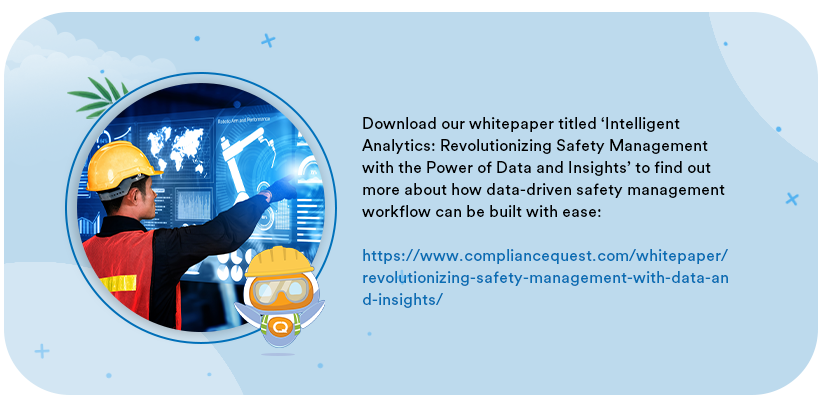From Data to Decisions: Leveraging Analytics for a Safer Workplace
PwC defines Safety Analytics as the science of studying the root causes of workplace accidents. Running analytics on safety data provides a framework for assessing, measuring, monitoring, and directing employee health and safety policies across the enterprise.
By establishing a safety management process that is data-driven, enterprises can:
- Proactively reduce the number of safety incidents
- Upgrade the root cause analysis and corrective action processes
- Understand safety risks ahead of time
- Use predictive models to prevent accidents before they occur
- Use safety observation data to upgrade processes/workflows with a safety-first approach
- Run better safety audits and inspections
- Lower the impact of an accident in case one occurs
- Improving response times and capabilities of on-ground workers


Data-driven safety management helps lower the cost of safety, improve profitability, and enhance employee well-being. This leads to better employee engagement and compliance with internal and external safety regulations and standards.
Businesses need access to reliable safety-related data and good AI-infused analytics tools that can provide safety leaders and managers with insights for improved decision-making. For instance, HSE Network, an EHS website and digital community for health and safety professionals, points out how data has helped to develop customized personal protective equipment based on the specific needs of the jobs being performed, the workplace environment, and the worker’s individual requirements.
Embedding sensors in PPE has also proved beneficial in identifying risks based on factors such as location, physiological parameters such as body temperature and heart rate, and the identification of hazardous materials in real time. This helps safety leaders respond immediately, use the data to identify patterns, and proactively implement mitigation strategies to improve the safety of the site/specific location.
Need for Data-Driven Safety Analytics
A Safety Maturity Survey of 150 safety leaders conducted by ComplianceQuest revealed that 49% still used in-house developed, baseline safety management systems. This was preventing their ability to become more proactive and data-driven when it came to safety risk management. Modern workplaces are becoming complex, and the risks are becoming more difficult to uncover and address. Conventional safety management systems are incapable of keeping pace due to cumbersome manual processes, siloed data, and reactive safety measures. The lack of real-time insights and predictive capabilities often leads to missed opportunities for preventing accidents before they occur. Often, companies react to events after they occur instead of being able to address risks proactively and minimize incidents.
Operational intelligence that uses data, analytics, and real-time monitoring enables anticipating risks and mitigating them preemptively. By integrating disparate data sources using digital solutions, organizations can get a unified view of safety performance. It empowers leaders with actionable insights for strategic decision-making.
Role of an Analytics Control Tower
A solution that acts as an Analytics Control Tower provides modern safety leaders with a global view of enterprise-wide data, transforming data into actionable insights, proactively identifying and addressing safety hazards, and implementing mitigation strategies with ease. It enables data analysis, capturing trends for informed decision-making. Safety leaders and managers can review safety performance, implement corrective action, and monitor progress to ensure the desired outcomes.
Some of the key features of the Analytics Control Tower include:
- Standardized Safety Management: Today’s businesses operate in multiple locations, and remote management can be a challenge in the absence of a global view. With a cloud-based safety solution that provides visibility into operations even in remote locations, thereby ensuring standardization of safety processes.
- Customize at Site Level: The Analytics Safety Tower also provides country-specific, location-specific safety data. When sites are located in a different geography, applicable standards may also be different. The tower provides data specific to the site, which can help tailor safety programs to meet the needs of the specific locations.
- Incident-Based Customization: Analytics Control Tower helps capture incidents, near misses, and observation-related trends. This enables assessing the frequency and severity of hazards and the risks they present. This helps safety leaders rank hazards and allocate resources efficiently to address critical issues.
- Tracking and Monitoring KPIs: Introducing a mitigative measure may mitigate the risk but introduce new ones. Therefore, it is essential to track the impact of the safety processes and ensure they are delivering as expected. Key performance indicators must be identified and quantified to enable tracking. They can be of two types - lagging and leading - and both provide actionable insights.
- Transparency & Accountability: Safety leaders can view and analyze CAPAs and their closure rates to improve accountability and ensure planned actions are implemented to enjoy the benefits. This also helps to drive efficiency and agility in the safety processes.
Faster and Smarter Decision-Making with Connected Analytics
The success of Analytics Control Tower depends on how effective it is, which is determined by data quality. The core components of a Safety Intelligent Analytics solution are:
- Data integration
- Real-time monitoring
- Incident management with data at the core
- Predictive analytics
Together, they provide a 360-degree view of the safety operations, ensuring the processes are streamlined for greater efficiency and productivity.
Key capabilities of CQ’s Safety Intelligent Analytics Solution include:
- Automated Data Collection: By automating safety data collection with automated tools, businesses can ensure accuracy and timeliness.
- Real-Time Monitoring: Safety metrics are monitored around the clock, and alerts are generated in case of potential issues, enabling timely action.
- Data-Driven Incident Management: Enables efficient response to safety incidents by helping contain their impact quickly and recording and documenting information as incidents unravel.
- Predictive Analytics: Safety leaders have easy access to historical and current data that helps to identify risk patterns and predict and prevent incidents.
The ComplianceQuest EHS Solution is a cloud-based solution built on the Salesforce platform. It integrates seamlessly with other business systems, such as ERP and CRM, providing safety leaders with a unified view of data from across the organization.
To find out more about how your enterprise can build and automate a data-driven safety management process, request a demo: https://www.compliancequest.com/online-demo/


